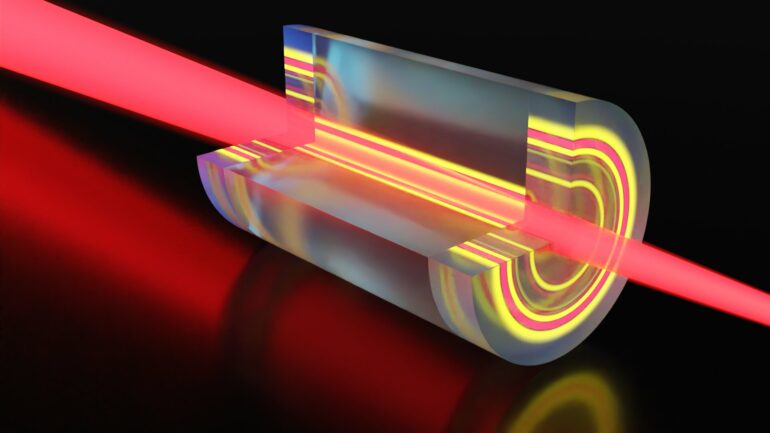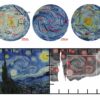An international group of researchers has measured how much a laser beam tugs on the water it shines through.
Since light constitutes an electromagnetic wave phenomenon, a laser beam shining through water is known to interact with it via process termed electrostriction, which implies the water being compressed towards the laser beam axis. This phenomenon is akin to squeezing a toothpaste tube; the paste is pushed inwards, which also moves it along the tube, forcing some toothpaste out of it.
Now, an international team of researchers has measured the force density exerted by laser light within a water column as it passes through it. “This is the first time the force density exerted by the light within matter has been measured; earlier experiments only measured the forces at the interface of different materials, or the net forces exerted on small particles,” says Nelson Astrath from the Universidade Estadual de Maringá.
The same analogy helps explaining how the researchers managed to measure the tiny force exerted by light. By closing the ends of the water-filled tube with glass plates, they effectively put the cap back onto the toothpaste tube. “This way, the transient compression could no longer force the water out along the path of the laser, thus making the electrostriction-generated elastic waves traveling away from the laser beam the dominant effect,” says Tomaž Požar from the University of Ljubljana. After measuring the properties of that wave, the researchers could calculate the forces involved.
Elastic waves caught between cuvette walls
The experiments, which were carried out in Brazil, had to control for other interactions which could swamp out this effect. “For example, lasers also heat water up a tiny amount for a brief moment, causing it to expand,” said Mauro Baesso and Gabriel Flizikowski from the Universidade Estadual de Maringá. To avoid this, the team had to use ultra-pure water, with nothing in it that would heat up by absorbing more electromagnetic energy than the pure water itself. The laser wavelength was also carefully controlled to minimize absorption.
“Electrostriction implies the atoms group closer to each other, increasing the density. This constriction is the opposite of the thermal expansion that normally follows electromagnetic absorption at room temperature. Because of this, the compression can only be measured in materials that have very little electromagnetic absorption,” says Mikko Partanen of Aalto University.
“Bulk and boundary optical forces in the liquid can be observed in the convoluted optical signal due to the resulting spatiotemporal pressure distribution. The pressure perturbation is related to compressibility thus signifying the electrostriction Helmholtz force. This force has been historically difficult to measure and accurately model,” says Iver Brevik from the Norwegian University of Science and Technology. “We are also able to distinguish between the radiation-induced thermal and nonlinear Kerr effects, thus consider these findings to be an important contribution to light-induced pressure perturbation experiments in dielectric fluids,” says Daniel Razansky from the University of Zurich and ETH Zurich.
“The experiment is a significant leap forward in formulating an exact time- and position-dependent optical force theory, which is theoretically and experimentally verified in an unambiguous fashion. In particular, the experiment quantitatively verifies the axial component of the optical force density for an optical beam. What still remains to be experimented with is the measurement of the longitudinal force component,” says Stephen Bialkowski from the Utah State University.
In addition to the experiments, the researchers produced a theoretical model to explain their results. “Further work is needed to properly understand different aspects of the model from the special theory of relativity point of view,” Bruno Anghinoni and Luis Malacarne added.
The study expands on Nobel Prize winner Arthur Ashkin’s findings, which he used to develop optical tweezers for manipulating tiny particles of matter with light. “The new research promotes our understanding of how an optical field produced by the tweezers affects the deformable matter being manipulated,” Nelson Astrath and Tomaž Požar added.
“The research could be employed in biology or medicine, among other potential applications. If optical electrostriction can be used to control the mechanical properties of matter, it could potentially be utilized in optical microelectromechanical systems,” says Jukka Tulkki from the Aalto University.
The study, “Unveiling bulk and surface radiation forces in a dielectric liquid,” has been published in Light: Science & Applications.
More information:
N. G. C. Astrath et al, Unveiling bulk and surface radiation forces in a dielectric liquid, Light: Science & Applications (2022). DOI: 10.1038/s41377-022-00788-7
Provided by
University of Maringá
Citation:
Unveiling bulk and surface radiation forces in a dielectric liquid (2022, April 20)



